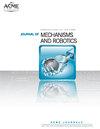柔性臂/缆索混合驱动并联连续体机械手的分析与验证
IF 3.2
4区 计算机科学
Q2 ENGINEERING, MECHANICAL
Journal of Mechanisms and Robotics-Transactions of the Asme
Pub Date : 2023-08-29
DOI:10.1115/1.4063289
引用次数: 0
摘要
缆索驱动并联机械手和并联连续体机械手由于其低惯性和高安全性,在拾取和放置操作中越来越受到关注。在缆索驱动的并联机器人中,缆索用于控制移动平台,而并联连续体机械手则使用柔性肢体。通过将这两类机构相结合,作者提出了一种新型的柔性肢索混合驱动并联连续体机械手(HDPCM)。柔性四肢具有承受施加在移动平台上的推力的能力,是HDPCM的关键组成部分。同时,缆索能够熟练地调节柔性肢体的形状并承受一定的拉力,从而减少了柔性肢体出现大分叉的可能性。这将提高操纵器的可达工作空间和负载能力。为了预测所提出的机械手的配置,利用基于离散化的方法进行了有效的运动学分析。在反问题的无穷多个解中,选择势能最小的配置作为最优解。最后,制作了一个原型,并进行了验证实验,结果表明该原型具有可接受的定位精度和被动柔顺性。此外,验证了所提出的机械手在工作空间和负载能力方面具有相对优越的性能。本文章由计算机程序翻译,如有差异,请以英文原文为准。
Analysis and Validation of a Flexible Limb/Cable Hybrid-Driven Parallel Continuum Manipulator
Cable-driven parallel manipulators and parallel continuum manipulators have attracted increasing attention in pick-and-place manipulation, owing to their low inertia and high safety. In cable-driven parallel robots, cables are utilized to control a moving platform, whereas parallel continuum manipulators employ flexible limbs.By combing these two types of mechanisms, the authors propose a novel flexible limb/cable hybrid-driven parallel continuum manipulator (HDPCM).The flexible limbs, equipped with their ability to withstand pushing forces applied on the moving platform, are a critical component of the HDPCM. Meanwhile, the cables, with their proficiency to modulate the shape of the flexible limbs and endure some of the pulling force, reduce the possibility of large divergence in flexible limbs. This results in an improved reachable workspace and load capacity for the manipulator. To predict the configuration of the proposed manipulator, an efficient kinetostaics analysis is given, utilizing a discretization-based approach. Among the infinitely many solutions to the inverse problem, the configuration with the minimal potential energy is selected as the optimal solution. Finally, a prototype is fabricated, and validation experiments are conducted, which demonstrate that the prototype exhibits acceptable positioning accuracy and passive compliance. Furthermore, the proposed manipulator is validated to possess relatively superior performance in workspace and load capacity.
求助全文
通过发布文献求助,成功后即可免费获取论文全文。
去求助
来源期刊

Journal of Mechanisms and Robotics-Transactions of the Asme
ENGINEERING, MECHANICAL-ROBOTICS
CiteScore
5.60
自引率
15.40%
发文量
131
审稿时长
4.5 months
期刊介绍:
Fundamental theory, algorithms, design, manufacture, and experimental validation for mechanisms and robots; Theoretical and applied kinematics; Mechanism synthesis and design; Analysis and design of robot manipulators, hands and legs, soft robotics, compliant mechanisms, origami and folded robots, printed robots, and haptic devices; Novel fabrication; Actuation and control techniques for mechanisms and robotics; Bio-inspired approaches to mechanism and robot design; Mechanics and design of micro- and nano-scale devices.
 求助内容:
求助内容: 应助结果提醒方式:
应助结果提醒方式:


